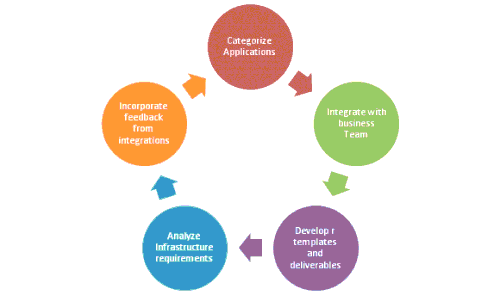As an IT professional, if you have been through mergers & acquisitions before, you know by now that not having a clear strategy/plan for integrating your IT systems can be disastrous. Effective IT/system integration strategy can have a huge impact on the actual business results of the integration.
There has been a lot of debate and discussion about how fast or slow the integration process itself should be. You can also follow the debate on Deloitte’s website.However my personal opinion is – the faster you get the integration done, the better it will be for both the parties.
Categorize your applications and integrate in a phased manner: All IT organizations have several applications which have been developed over many years. Some are life blood applications, some are strategic differentiators, some are essential to keep the business running and some applications have been developed to address a one off business problem. This would be a great opportunity to clean up the portfolio and develop a plan to retire the rarely used or never used applications. In general the strategy should be to integrate the applications which fall into the lifeblood applications and KBR category like ERP, DW/BI, Invoicing, HR and financial applications in phase 1, integrate the applications supporting ancillary business processes like travel booking, geography specific leave applications etc in phase 2 and retire the rarely used/never used applications.
The M&A IT Integration Cycle 
Integrate with the mergers and acquisitions (M&A) team right upfront: IT has to be part of business growth strategy and not an afterthought. If the IT integration team is not part of the M&A team right upfront from the due diligence phase, then there is something seriously wrong with the picture. Integrating systems and processes has a huge impact on the entire process. For example: if your organization is used to the process of project managers/ client engagement executives sending out invoices to the customers but in the company you are trying to acquire, this process is handled by finance, it can be a major point of concern. The IT team members who work closely with the overall M&A team have to have a deep and thorough understanding of the business process the applications align with and analyze the impact. In fact, the best way to integrate is to develop an IT risk assessment document and ensure the risks /mitigation strategies are embedded into the overall M&A framework.
Develop clear templates and deliverables at each phase: An effective IT integration strategy will be aligned with the overall M&A strategy. Depending on the stages your organization follows for integration like due diligence, offer, acceptance and signing and post merger, IT strategy also has to evolve with the business phases. IT can only be effectively aligned if each phase of the strategy has a clear set of activities, pre-defined documents/templates which can be used by any team member without too much of knowledge transfer and clear deliverables which articulate the key concerns/issues or measures. For ex: the IT team should highlight the major risks in the process of integration, suggest an ideal timeframe for integration based on all the factors in the due diligence phase. A clear step by step project plan for integration should be developed as part of signing and closing phase and finally templates should be in place to report weekly during the post signing and integration process and stake holders should be able to identify/ address the major challenges/concerns.
Infrastructure plays a key role: Integrating IT does not start or end with integrating applications. It starts with integrating the infrastructure like networks, telephone systems and goes well beyond applications with IM and chat support, rolling out of help desk and finally the email setup. There are 2 sticky points I have faced with integrations: a) Size limit on emails – this can be a very difficult issue to handle especially in cases where larger organizations are taking over smaller organizations. Large / medium companies tend to have strict quotas on email whereas smaller companies are liberal with their email quotas. And, b) Always plan on retaining the client email client and forward emails to the new address for longer period of times. Consider this example: Let us say you lost your American express card and you call up AmEx to send you a new card, AmEx will send you a new card in 24 hours and will also remind you to change the card numbers in various places which put charges on your account on a recurring basis. However, it does not cut off the recurring charges going to the old card right away. They are cut off only after an extended period of time (sometimes 3-6 months only where there is a history of recurring charges from a specific vendor) and it is totally seamless to us as customers. The switch in email clients and addresses also has to be as seamless if not better than that; especially in situations where employees are constantly interacting with customers. This is an area where PaaS can really help expedite the integration process.
The IT integration playbook for M&A, like any other document, is always a living and breathing document. Lessons learned from each integration have to be incorporated and templates have to be updated. An effective IT integration strategy can reduce the integration timeframe by 50% and save your company several million of dollars.
Copyright © 2010 Sarat Varanasi


